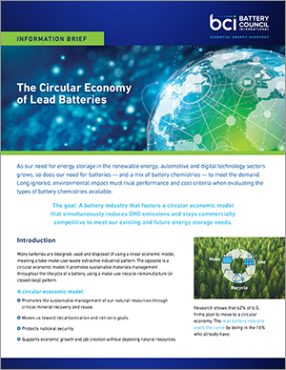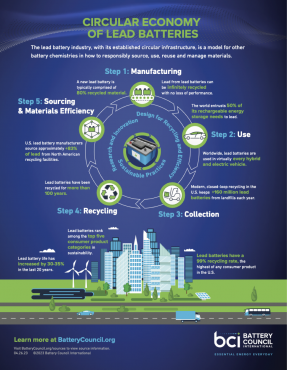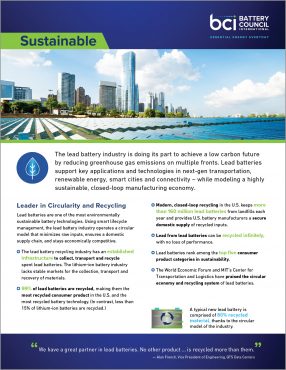
Our guest blogger, Dr. Carole Mars with The Sustainability Consortium (TSC), discusses the benefits of the lead battery sustainability model, especially during a global pandemic that is interrupting supply chains. Dr. Mars is TSC’s Director of Technical Development and Innovation. As policymakers explore how to ensure domestic sources of essential goods and services, the lead battery model can serve as an example.
The U.S. lead battery manufacturing and recycling industry has long practiced circularity. The industry’s ability to collect and recover used batteries as feedstock for new ones not only keeps valuable materials in use and potentially dangerous chemicals out of the environment but secures a reliable domestic supply chain for battery manufacturers. The global pandemic has highlighted many weaknesses in supply chains that rely on imports and how important it is to know the source of materials needed to manufacture products. As more companies move to understand how their supply chains work, the circular model developed in the lead battery industry is one to study.

A Circular Economic Model
As part of my work at The Sustainability Consortium (TSC), whose mission is to help make consumer products worldwide more sustainable, I have had the opportunity to engage with the successful lead battery circular economy model. The primary tools we have developed to understand sustainability performance in supply chains are a series of surveys that look at the impacts and improvement opportunities across the full lifecycle of a given product category. Companies can use the results of these surveys to identify and address potential sustainability risks in their supply chain and communicate their efforts to their customers. Buyers can use this information to help purchase more sustainable products and inform decision-making around
The lead battery companies who have responded to the survey do very well because of the active product takeback programs managed by the manufacturers, efficient recycling processes, and high amounts of recycled materials in a new battery. These are key components of the circularity of material flow that the industry has created – lead batteries have closed the loop more effectively than almost any other product in the consumer goods space, reflected in their 99% recycling rate in North America. Furthermore, that recycling rate means a large percent of U.S. lead battery manufacturing supply chain inputs (73% of its lead) are sourced from domestic recyclers. Getting this product into a “loop” has been a great advancement and something this industry has done much better than others.
The Benefits of Circularity
A new battery is roughly 80% recycled material. Keeping lead battery materials in circulation for as long as possible increases:
- Sustainability: Recycled materials greatly reduce manufacturers’ need for virgin materials and mining – domestic and foreign – which reduces their environmental impact due to sourcing. Additionally, because the materials are sourced locally or regionally from battery recyclers, there is less transportation and shipping needed which lowers emissions and, thus, carbon footprint. The lead battery industry as a whole uses far more recycled material than virgin material. None of the other battery chemistries have reached that point yet; they are still heavily reliant on virgin materials and imports for production.
- Reliable material sourcing: Manufacturers have a consistent supply of high-quality inputs, which ensures product availability, despite global disruptions from natural disasters, political uncertainties and import tariffs.
Lead Batteries’ Circularity and Economic Viability
The lead battery industry has achieved economical viability within its circular supply chain through several key enablers. Foremost, is the industry’s longevity (age is a good thing here). They’ve had time to evolve and address issues, like cost-effective recycling.
Here are other factors:
- Design: Not only the product but also the entire life cycle is designed to optimize resource recovery and reuse. The standard design of lead battery and its minimal componentry is a huge plus.
- Scale: Adequate quantities of used batteries are available to justify investments in recycling infrastructure. Lead batteries’ high recycling rate provides the materials needed for new batteries.
- Policy: Regulations have prohibited inappropriate disposal, established appropriate incentives though core charges to ensure consumers recycle their batteries, and enabled manufacturers to recycle both their own as well as competitors’ products. These are examples of how policy can have a positive influence to improve sustainability and support circular economy models.
- Collection: Lead batteries have a well-established, coast-to-coast collection network. It’s effective at collection and getting the word out to people that these batteries should come back. It makes it very local and immediate. That has been one of the biggest successes for lead batteries.
- Logistics: The logistics of getting batteries back to where they need to go isn’t discussed much, but it’s an essential topic since logistics can be the most expensive part of recycling. The lead battery industry has done what other have yet to do – figure out and optimize reverse logistics to recapture value and/or ensure proper disposal.
- Continuous improvement: Through THESIS, TSC measures sustainability by how well a company knows its supply chain. How well are you talking to your vendors both upstream and downstream of where you are? What are you doing to address those issues that are going to make you more sustainable? How can the system be more efficient and effective? The lead battery industry takes continuous improvement very seriously and is always looking at how they are going to continue raising the bar.
Will Pandemic Affect Sustainability’s Momentum?
I believe COVID-19 will be a net positive for sustainability. The crisis has made input sourcing more transparent. Shortages on shelves has made supply chain challenges real to many people in a way that hasn’t happened in our lifetime. Going forward, it will be harder for companies to assume stability in their supply chains. This won’t stop global trade, but it could mean multi-national companies try harder to create closed loops within each country or region where they operate.
It’s much easier to understand how your supply chain works if you have control over all aspects of it, which the lead battery industry nearly does through its closed-loop system.
We need to leverage their lessons learned to help other industries have the same type of performance for their used products to improve sustainability, create more circular material systems, and reduce supply chain risk.








